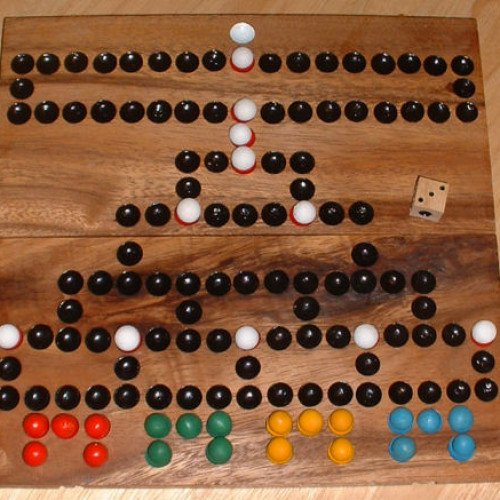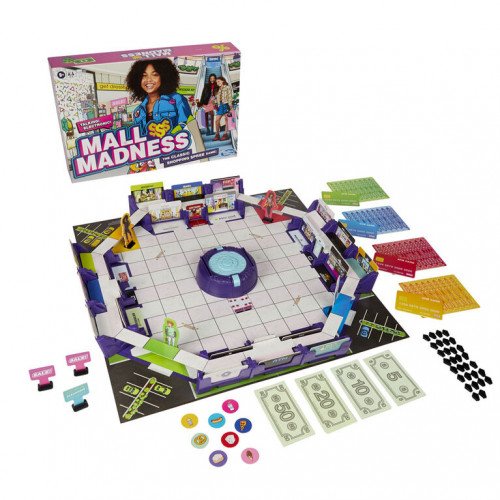"MALEFIZ" vs "MALL MADNESS"

MALEFIZ
Malefiz (also known as Barricade) is a strategy board game, invented by Werner Schöppner and published by Ravensburger since 1960. It is a non-circular descendant of the ancient Indian board game Pachisi. The name of the game borrows the obsolete German word Malefiz, meaning "misdeed" or "bad action". The word was derived from the Latin word maleficus, meaning "mischievous" or "profane". First play may be determined by a die-roll or another manner of the players' choosing. At the beginning of each turn, the active player rolls the die. That player selects one of her five pawns and moves it a number of steps equal to the number shown on the die. That pawn may begin traveling in any direction and may turn to continue through corners in the path, but it may not double-back along its course, and it may not forgo any steps. The spaces within the players' houses are not counted against the die-roll; the first space counted by any pawn is the space immediately above the house. During the course of a move, a pawn may pass other pawns (regardless of colour) with no effect. In the event that a pawn finishes its move by landing on a space occupied by another pawn, the pawn occupying that space is captured. Captured pawns are returned to their respective houses and become available to rejoin play upon their owner's next turn. Unlike pawns, barricade pieces may not be passed. In order for play to progress past a barricade, the barricade must be captured by a pawn. A player who captures a barricade must relocate the barrier to an unoccupied space on the board. Barricades may not be placed in the four houses or in any of the 17 spaces in the bottom-most row. A pawn may not be moved if doing so would cause it either to pass a barricade or to overshoot the uppermost space on the board. After the move is complete, play passes to the next player. A player may forgo her move if and only if none of her pawns may be moved.
Statistics for this Xoptio

MALL MADNESS
Mall Madness is a shopping themed board game released by Milton Bradley (later versions are titled as Electronic Mall Madness). The original game was released in 1988, and an electronic talking version was sold starting in 1989. Milton Bradley updated the game in 1996 with a new design, and another updated version was released in 2004. A redesigned version was released in 2020. The game was designed for players aged 9 and up. The targeted consumer was teenage girls, usually 11 to 16 years old. Milton Bradley made several commercials for the game. In one from 1990 the camera showed alternating shots of four girls shopping in a real shopping mall, and playing the game at home. After one girl moves her pawn to the game board's parking lot she exclaims: "I win!" The other three demonstrate dismay at having lost. The commercials last line is "Mall Madness, it's the mall with it all!" Another version has recently been released; a Hannah Montana special edition and a "Littlest Pet Shop Edition". The Hannah Montana version was the first version to picture a male on the front of the box. Mall Madness was sold with the following pieces; Box, game board, electronic computer, instruction manual, four rubber pads to prevent wall pieces from slipping, six plastic wall pieces, four cardboard shopping lists, two sale & one clearance signs, eight plastic pawns (two for each colour; red, blue, yellow and green, one was female the other male), forty plastic pegs (used to mark shopping lists), paper money (that resembles U.S. currency, except each bill denomination is color-coded for the game), four cardboard credit cards, and 29 pieces of cardboard which held the game board together.